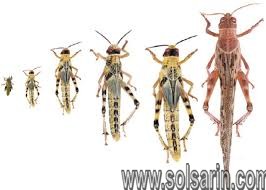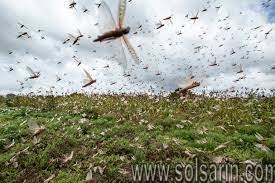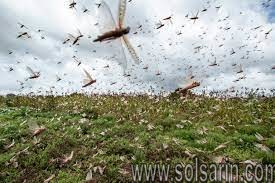what do locusts look like
hello dear friend .thank you for hcoosing us. in this post on the solarin site,we will talk about what do locusts look like.
stay with us. thank you for your choice.
What do grasshoppers, locusts, crickets and katydids look like?


Size:
- 5 mm – 100 mm in length.
Body:
- Variable from stick-like to bulbous but commonly widest at wing attachment (wide shoulders) with a tapering abdomen.
- Pronotum (segment behind head) draped over sides to form large lateral lobes.
- Body appears hard.
- Eyes:
- Large, bulbous and well separated.
- Some forms found in caves have very small eyes or none at all.
Wings:
- One or two pairs if present.
- Forewing hardened, leathery and partially see-through or cloudy.
- Hindwing much larger than forewing, membranous, clear and folds like a fan.
- Both wings have numerous cross-veins forming many cells.
- Wings usually cover the abdomen but short wing species are common in some groups.
- At rest the wings are held tent-like or flat over body, hindwings hidden
Abdomen tip:
- Two short cerci (tails).
- Males have clasping organs while females of some groups have a long prominent spike known as an ovipositor (which is used for laying eggs)
What do grasshoppers, locusts, crickets and katydids do?
- They are normally solitary. Some grasshoppers and locusts form foraging swarms while crickets may be found in small groups.
- When disturbed they usually jump, run quickly under cover, or jump into flight usually landing soon after. Some remain still or burrow, while others may have threat displays including, flashing warning colours, or noise-making.
- Most fly in short bursts but some such as the locusts can fly for extended periods. Many usually make slapping, buzzing or whistling sounds as they fly.
- Many grasshoppers and katydids are experts at camouflage. They use behaviour or colouration patterns, and special body forms to help them blend in with their surroundings. For example, some look like twigs, leaves, rocks or bark. In some circumstances they may also look and behave like other insects.
- Some such as mole crickets are strong burrowers.
- Many, especially crickets, are sound producers.
- To create sound they use special structures along the base of their wings, sides of the abdomen or along their legs. Often these sounds are used to attract potential partners.
- Most are herbivores (plant feeders) and eat a variety of plant materials such as leaves, roots, flowers, pollen, nectar, seeds and fruits. Alternatively some will eat animal and plant debris, lichens and mosses, and a number are predators
What looks similar?
- Stick insects can be confused with grasshoppers that look like sticks.
- Stick insects can be distinguished by their pronotum, which does not drape over the sides to form lobes.
- They also have tarsi (toes) with five segments and wings that are always shorter than their abdomen.
Are Cicadas and Locusts the Same Thing?
Though they do share some similarities, and the names have been improperly used interchangeably almost since Cicadas were first discovered in North America, Cicadas and Locusts are not the same!
if one looks at Cicadas vs Locusts: what’s the difference though? In simplified terms, a Cicada is more similar to an aphid, while a Locust is a type of short-horned grasshopper.
If you’re looking for more specifics, don’t worry! We’re going to list many of the similarities and differences below, including what each insect’s basic life cycle is and what sort of sound each one makes.
The biggest difference between Cicadas and Locusts is probably that, while they do emerge in very large numbers when they hatch, Cicadas do not swarm as Locusts do.
Cicadas also do not decimate and consume crops in the same way as Locusts.
Locusts and Cicadas are both herbivores, but Cicadas are far less destructive when they feed. In fact, a lot of the damage Cicadas cause to plants comes from their egg-laying process, as opposed to their feeding habits.
Locusts are
both longer and thinner than Cicadas, with the long back legs common to all grasshoppers.
Cicadas have very small legs. Periodical Cicadas, the kind that only emerges from underground every 13-17 years, are only found in North America, where swarming Locusts have not been found since the Rocky Mountain Locust went extinct in 1902 and the High Plains Locust nearly so after a plague in 1930.
There are some similarities between these two insects.
Both Cicadas and Locusts have wings, though Locusts tend to fly much greater distances.
Both of these creatures eat plants and lay eggs. They are both very loud and usually appear in large groups.
Neither Cicadas nor Locusts are aggressive toward humans, though it might feel that way if a large group of them in flying and you get in their way!
Family


Cicada
Cicadas are in the family Cicadidae, which covers any bug that makes a sound, has prominent eyes, two membranous pairs of wings, and both compound and simple eyes.
Locust
Locusts are Acrididae. That family designation refers to any short-horned grasshoppers which migrate and swarm in great numbers.
Size
Cicada
Cicadas are typically about two inches long and half an inch across.
Locusts
(derived from the Vulgar Latin locusta, meaning grasshopper) are a group of certain species of short-horned grasshoppers in the family Acrididae that have a swarming phase.
These insects are usually solitary, but under certain circumstances they become more abundant and change their behaviour and habits, becoming gregarious.
the basis for the definition is whether a species forms swarms under intermittently suitable conditions.
Normally, these grasshoppers are innocuous, their numbers are low, and they do not pose a major economic threat to agriculture.
However, under suitable conditions of drought followed by rapid vegetation growth, serotonin in their brains triggers a dramatic set of changes: they start to breed abundantly, becoming gregarious and nomadic (loosely described as migratory) when their populations become dense enough.
They form bands of wingless nymphs that later become swarms of winged adults.
Both the bands and the swarms move around and rapidly strip fields and cause damage to crops.
The adults are powerful fliers; they can travel great distances, consuming most of the green vegetation wherever the swarm settles.
resources:wikipedia
As food
Locusts are edible insects.
They can be cooked in many ways, but are often fried, smoked, or dried.[60] The Bible records that John the Baptist ate locusts and wild honey (Greek: ἀκρίδες καὶ μέλι ἄγριον, romanized: akrides kai meli agrion) while living in the wilderness.
The Torah, although disallowing the use of most insects as food, permits the consumption of certain locusts; specifically, the red, the yellow, the spotted grey, and the white are considered permissible.
In Islamic jurisprudence, eating locusts is considered halal.
The Islamic prophet, Muhammad, was reported to have eaten locusts during a military raid with his companions.


locust,
(family Acrididae), any of a group of insects (order Orthoptera) that are distributed worldwide, the common name of which generally refers to the group of short-horned grasshoppers that often increase greatly in numbers and migrate long distances in destructive swarms.


In North America the names locust and grasshopper are used for any acridid.
Cicadas (order Homoptera) also may be called locusts, the 17-year “locust” being the 17-year periodic cicada.
The grouse (or pygmy) locust is a member of the family Tetrigidae (see pygmy grasshopper).




